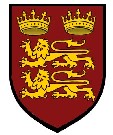
Return to St. Bartholomew main page
Photographs and text copyright Tina Bird 2003-2006
Last modified: 7 Apr 2006

My goal in this essay is to translate Henry's charter to more modern English vocabulary; to supplement it with the financial resources represented by advowsons given to the priory in the first two centuries of its existence; and in the end to help explain the resources required and available to this relatively wealthy house in medieval London. NB: I am not an expert on property rights, the medieval church, or any other discipline that might reasonably be expected to qualify my opinion on this topic as either expert or accurate. Please feel free to contact me with questions, corrections, suggestions for further reading or other comments.
If all goes well, I may supplement this work with a discussion of the money required for Sir Aston Webb's restoration of St. Bartholomew's. A surprising amount of ephemera related to turn of the century fundraising drives is available to the diligent hunter, especially in the form of postcards and small-press publications.
According to the Book of the Foundation, Rahere returned from his Rome pilgrimage on fire to build the church and hospital he'd promised to St. Bartholomew. First he consulted his colleagues from the city, "barons of London." These citizens confirmed what he probably already knew, that in order to build anything of significance in the marketplace in Smithfield, Rahere would need permission from the Crown. Apparently Henry I received the request graciously, perhaps with subtle encouragement from St. Bartholomew himself: he [Rahere] betook himself at an opportune time to the king and, in the presence of Bishop Richard [then Bishop of London] , whom he had won over to himself as a supporter, he effectually explained his business, and humbly besought to be allowed to bring his purpose to performance. Forthwith He, in whose hand he was, inclined the king's heart to his desire, nor could prayers be ineffective whose author was the apostle, whose hearer was God. So his saying was pleasing in the eyes of the king and, considering the man's wish to be very good, and as he was of a prudent mind, he bestowed his royal favour upon his petitioner, and graciously gave him authority to carry out his proposals.
The king's approval and authority was vital for two reasons. Nothing could happen until Rahere had land upon which to build the church, the hospital and the residential buildings required for the prayers and charitable works he'd promised the Apostle. Only the king could grant that land, as St. Bartholomew had specified Smithfield as the location, where the market and surrounding fields were held by the king. But royal patronage carried a deeper, longer-term benefit. Clearly, Rahere's institution could not exist without real estate and buildings. But just as necessary, St. Bartholomew's needed ongoing, recurrent revenue, to support the canons and their work. This revenue would be derived from several sources: land held directly by the priory, and then rented or farmed; the patronage of parish churches, which led to income through donations and from the right to grant the "living" of those churches; and from taxes, tolls and fees associated with the fair held on the feastday of St. Bartholomew's.
[The numbers in the following discussion refer to the modern English translation of the charter. Use your "Back" button to return to the charter.]
(1) Henry establishes St. Bartholomew's, the priory of regular canons founded by Rahere, as a demesne chapel. In feudal times, "demesne property" was held by the lord for his own use. By using this language, Henry exempts the priory from all royally-imposed duties, such as paying taxes or providing military service, in the same way that his own home was exempt. These exemptions are spelled out in detail in the next paragraph. [But Webb points out that despite this language in the charter, which was confirmed during the reigns of the next several Norman and Plantagenet kings, St. Bartholomew's did provide money and/or goods during wartime and other points of royal need. I don't know if that's because the exemptions became less meaningful over time, or because the prior and his officers realized that voluntary payments were an effective way to maintain royal good will!]
(2) This paragraph names the various sorts of royal taxes, tolls, and fees from which this charter releases St. Bartholomew's. These include a variety of fees related directly to travel (ie. tolls for using a bridge, fees collected to transport goods for sale, customs charges); fees collected for the maintenance of public access (ie. bridge maintenance, road maintenance); fees related to selling goods at a market or fair; resources required to administer justice; property taxes; providing money or men for military service, whether for defense or abroad.
I've found these books particularly useful in my quest to understand how St. Bartholomew's kept its financial head above water. Full details are in the Bibliography:
and, of course, Webb's Records.Crossley's The English Abbey: Its Life and Work in the Middle Ages
Dickinson's Origins of the Austin Canons
Platt's The Abbeys and Priories of Medieval England
Stenton's Anglo-Saxon England
 |
Return to St. Bartholomew main page Photographs and text copyright Tina Bird 2003-2006 Last modified: 7 Apr 2006 |
 |